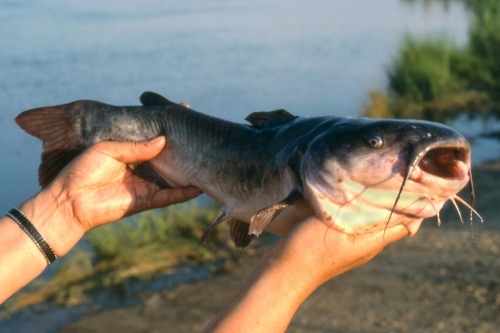Catfish are known for their amazing whiskers all around the world. It’s a big fish (Although some are smaller ones) that lives in both rivers and the sea. This fish is distinguished by its whiskers and fat. Either in its whiskers or its jaw, it has the look of a cat.
The dorsal and pectoral fins of the catfish have spines that defend it from predators. It also has two barbels, one of which is larger than the other, as well as a head that is rather wide.
These fish have an elongated body about 30 cm in length. The body is mainly gray or grayish-brown in color and is often covered laterally in small white spots. The skin is covered with scales in addition to a kind of mucus that protects the fish when it is out of the water.
Many people who are fond of catfish wonder if these animals have backbones. However, before answering this, it is essential to know if these fish have bones.
Bones can be found in catfish. They have the main bone that looks like a spine, as well as minor bones that look like ribs. The fact that those bones are massive and organized is crucial. The primary bone is found near the top of the catfish’s body, and the minor bones are connected on both sides. These are notable for being stiff and short.
The spines of this fish contain ridges, and the spine glides into a groove on the catfish’s pelvic girdle. The fish’s swimming capabilities are improved as a result. Certain catfish have bony plates on their skin that are known as “scutes.” The scutes are a type of body armor that can be seen on all catfish species.
Catfish have a flattened dorsoventral skull. The skull is made up of several bones, and the connections between them are quite weak.
You’re probably aware that there are over 3000 species of catfish in the world, and while each one has anatomical variances to some degree, the bone structure of all of them is pretty similar.
Table of Contents
Do Catfish Really Have Backbones?
As we have said before, catfish have bones. Simply put, they are considered bony fish, so they obviously have a backbone.
Many people believe that these animals are invertebrates; that is, they do not have a backbone, but that is not true. Indeed, this fish can be considered a vertebrate animal specifically because it has a backbone.
Why Does the Catfish Have a Backbone?
The aim of a catfish’s skeleton, regardless of the type, is to safeguard organs, aid in mobility, and provide help and stability to the body.
That is why, as humans, most fish, including catfish, are vertebrates. The spinal cord, also known as the notochord, is a hard, lengthy rod that runs through the middle length of the body of this fish.
Knowing the different varieties of fish in the globe will increase your experience with them, whether you’re an angler, marine biologist, aquarist, etc. It should make you appreciate their ancestors and evolution even more. After all, fish have been around for much longer than humans.
Are All Fish Vertebrates?
For fish, there are 2 kinds of skeletons: exoskeletons and endoskeletons. The exoskeleton is a hard external structure consisting of bone or cartilage, whereas the endoskeleton is the interior support system where the spine or backbone links to the ribs.
Bony fish, like catfish, have an exoskeleton surrounding their fins, even though no species has a whole exoskeleton. Every fish has an endoskeleton.
Knowing That a Catfish Has a Backbone, How Should We Cut It Before Cooking?
Wanting to know if a catfish has a backbone or not can be due to many reasons, be it curiosity, study reasons, or simply for gastronomic use. If the latter is your reason, then it is essential that you know how to cut a catfish before cooking it.
The first step is to cut the catfish through the skin behind the head. Make a full circumference incision around the “neck,” but don’t chop off the head. After that, the fins must be removed.
Following that, the skin should be removed from the body. That may be tough and uncomfortable based on the catfish species. In addition, farm-raised catfish are easier and quicker to clean than wild ones. A couple of pillars, a sharp knife, caution, and a lot of patience are all required.
After you’ve removed the skin, you can start to chop off the catfish’s head, as well as the guts and organs.
In this phase, you must make the dorsal incision and a deep cut down the backbone. Now you should cut around the tail before continuing to cut from the bottom. Slice the ribs slowly and carefully when you get to them.
The goal is to get all of the ribs out of the fillet. After that, turn the fish over and repeat the process.

